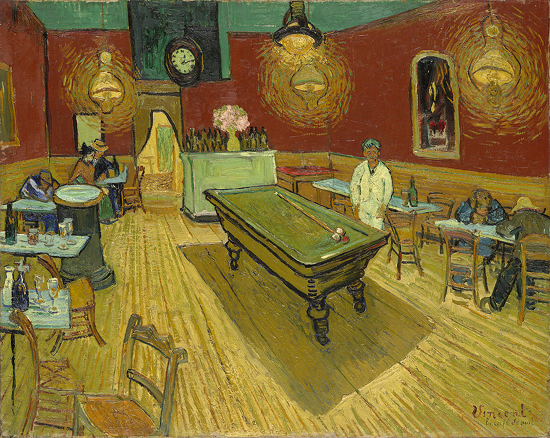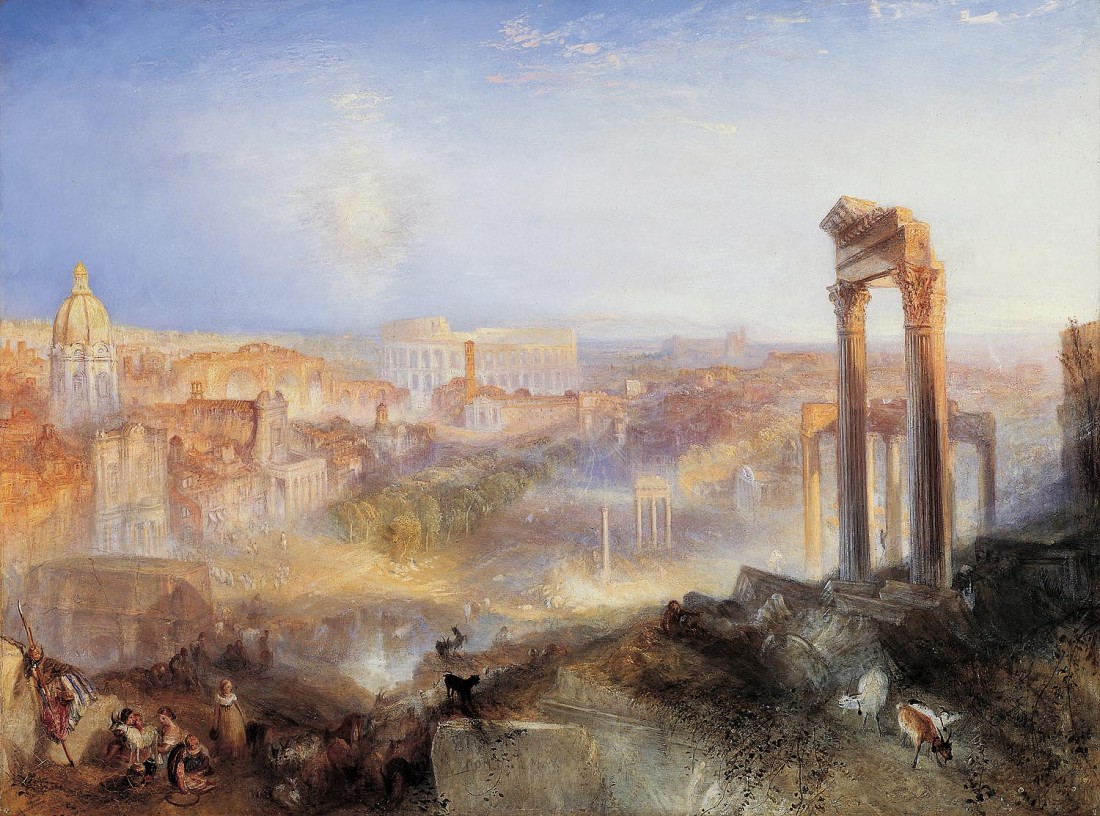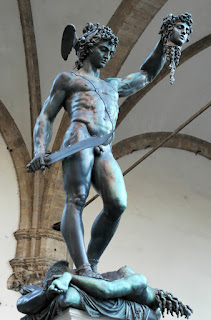Saturday, March 27th, 2010
Category
19th century
Saturday, February 27th, 2010
Van Gogh News!
 What immediately comes to your mind when you think of paintings by Van Gogh? Sunflowers? Starry nights? Creepy self portraits with bandages that cover up a mutilated ear? Well, my friends, it looks like you can add new subject matter to Van Gogh’s oeuvre: a windmill and tricoleur flag. This painting on the right, Le Blute-Fin Mill (1886) was recently authenticated as a Van Gogh painting. Honestly, I never would have considered this to be by Van Gogh, mostly because of the human figures: not only are the uncharacteristically large, but there are a lot more bodies than you normally see in Van Gogh’s work. But I really like the use of color, and that does remind me of Van Gogh. I especially like the red highlights of the woman’s dress in the foreground. What do you think? Do you like this painting?
What immediately comes to your mind when you think of paintings by Van Gogh? Sunflowers? Starry nights? Creepy self portraits with bandages that cover up a mutilated ear? Well, my friends, it looks like you can add new subject matter to Van Gogh’s oeuvre: a windmill and tricoleur flag. This painting on the right, Le Blute-Fin Mill (1886) was recently authenticated as a Van Gogh painting. Honestly, I never would have considered this to be by Van Gogh, mostly because of the human figures: not only are the uncharacteristically large, but there are a lot more bodies than you normally see in Van Gogh’s work. But I really like the use of color, and that does remind me of Van Gogh. I especially like the red highlights of the woman’s dress in the foreground. What do you think? Do you like this painting?
This authentication is pretty exciting – Le Blute-Fin Mill is the first Van Gogh to be authenticated since 1995. However, admittedly, the painting has long been disputed as by Van Gogh – an eccentric art collector bought the painting and always claimed it to be by the master, but no one took the collector seriously. You can read more about the story and authentication here.
 In other Van Gogh news, the famous The Night Cafe (1888, shown left) is involved in a dispute regarding ownership. This painting has hung for almost fifty years in the Yale University Art Gallery, but now Pierre Konowaloff, the great-grandson of the previous owner, is trying to claim the painting back. It seems like a pretty sticky situation: Konowaloff’s great-grandfather bought the painting in 1908, but it was subsequently nationalized and sold by the Soviet government during the Russian Revolution. Therefore, Konowaloff believes that the painting classifies as “stolen” and feels justified in claiming it back.
In other Van Gogh news, the famous The Night Cafe (1888, shown left) is involved in a dispute regarding ownership. This painting has hung for almost fifty years in the Yale University Art Gallery, but now Pierre Konowaloff, the great-grandson of the previous owner, is trying to claim the painting back. It seems like a pretty sticky situation: Konowaloff’s great-grandfather bought the painting in 1908, but it was subsequently nationalized and sold by the Soviet government during the Russian Revolution. Therefore, Konowaloff believes that the painting classifies as “stolen” and feels justified in claiming it back.
I personally don’t think that Konowaloff has a very good chance of getting The Night Cafe back, but what do other people think?
Tuesday, February 16th, 2010
Equality Leading the People
 Delacroix, Liberty Leading the People, 1831
Delacroix, Liberty Leading the People, 1831
From what I can tell, Delacroix never made Equality Leading the People, and Thoré may have been discussing only hearsay. Nonetheless, this got me thinking. What type of figure would Delacroix have picked to represent Equality? Given the context of the 1848 socialist revolutions, I’m guessing that he would have picked some type of proletarian (member of the working class).
I think that Equality Leading the People would have contained an interesting idea that is still relevant with current issues. What if Equality Leading the People was being painted today? What figure would you pick to represent Equality? My first thought was Martin Luther King, Jr. or Rosa Parks. What person (or generalized type of figure) would you choose?
1 Théophile Thoré, “Salon of 1848” in Art in Theory: 1815-1900, edited by Charles Harrison, Paul Wood and Jason Gaiger, (Oxford: Blackwell Publishing, Ltd., 1998), 181. (Is available online here).
Wednesday, January 13th, 2010
Loggia dei Lanzi and Subjugation
Several years ago, I sat in the Loggia dei Lanzi (Florence) and sketched some details of the statues found there. If I had thought hard about it, I might have noticed that several of the sculptures there share an interesting commonality. See if you can find the common theme:
(I recently wrote a post about Perseus here.)
 Pio Fedi, Rape of Polyxana, 1866
Pio Fedi, Rape of Polyxana, 1866
 matter which emphasizes the subjugation of women or “man’s longed-for control over woman.”1 I’ve been reading an article this week by feminist Yael Even who reveals this common theme in the loggia space. It’s quite fascinating. The most interesting thing to me, though, is that another sculpture used to be located here. Donatello’s Judith and Holofernes (1456-57, shown right) was the first sculpture placed in the Piazza della Signoria (where the Loggia dei Lanzi is located). However, over time, Donatello’s sculpture was shuffled around different sections of the loggia and elsewhere. In 1980, the sculpture was eventually moved (concealed?) to the inside of the Palazzo Vecchio. Yael Even points out that the difficulty with placing this sculpture has to do with the subject matter – instead of emphasizing the subjugation of women, Donatello’s sculpture depicts a woman killing a man.1
matter which emphasizes the subjugation of women or “man’s longed-for control over woman.”1 I’ve been reading an article this week by feminist Yael Even who reveals this common theme in the loggia space. It’s quite fascinating. The most interesting thing to me, though, is that another sculpture used to be located here. Donatello’s Judith and Holofernes (1456-57, shown right) was the first sculpture placed in the Piazza della Signoria (where the Loggia dei Lanzi is located). However, over time, Donatello’s sculpture was shuffled around different sections of the loggia and elsewhere. In 1980, the sculpture was eventually moved (concealed?) to the inside of the Palazzo Vecchio. Yael Even points out that the difficulty with placing this sculpture has to do with the subject matter – instead of emphasizing the subjugation of women, Donatello’s sculpture depicts a woman killing a man.1
When looking at all the depictions of female subjugation in the loggia, it’s no wonder that this sculpture sat uneasily (literally!) with the Florentines. After all, wouldn’t it make a (male) viewer uncomfortable to know that women can retaliate?
I really recommend that you read Even’s article.
1 Yael Even, “The Loggia dei Lanzi: A Showcase of Female Subjugation,” in Woman’s Art Journal 12, no. 1 (1991): 10.
2 Ibid.
Monday, January 4th, 2010
Banksy + Degas = Simon Cowell
 If someone asked me to guess American Idol judge Simon Cowell’s taste in art, I probably would have named something sensible, marketable, and creative – maybe some work by an abstract expressionist painter like Morris Louis. But my guess would have been way off.
If someone asked me to guess American Idol judge Simon Cowell’s taste in art, I probably would have named something sensible, marketable, and creative – maybe some work by an abstract expressionist painter like Morris Louis. But my guess would have been way off.
So what kind of critique did Cowell give his Christmas present? According to sources, the judge looked at the painting and immediately called it “hilarious.” What a news flash – I guess Simon Cowell has a sense of humor! And in true Cowell fashion, this is an expensive sense of humor: this “hilarious” painting is estimated to cost $800,000. That’s a lot of money for a joke.

